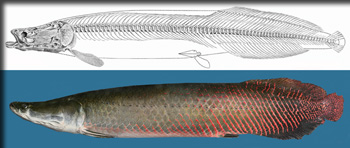 |
| Prof. Stewart with A. leptosoma. Photo credit: SUNY-ESF |
Arapaima is a genus of large-sized (up to 2.5 m and 200 kg) freshwater fish found in South America. The new species name, derived from Greek, refers to the organism's relatively slender ("lepto") body ("soma").
 |
| Arapaima via ESF.edu |
1) Shape of the dorsal sensory cavity,
2) Underlying bone structure of the head which makes the head relatively flat,
3) Dorsal fin sheath covering anterior dorsal rays.
Listen to this interview from Northeastern Public Radio (WAMC) of Prof. Stewart describing how the new species was identified.
Arapaima live in backwater areas of the Amazon rainforest, these waters are often oxygen-poor, which makes their primitive air-breathing lung an advantageous trait.
 Indigenous peoples have long depended on arapaima as a food source. With new knowledge of arapaima species diversity, biologists are becoming concerned about species conservation, particularly because not enough information is known regarding their spatial distribution and abundance. Charismatic mega-fauna, particularly those hunted for sport, are especially vulnerable to the threats of over fishing.
Indigenous peoples have long depended on arapaima as a food source. With new knowledge of arapaima species diversity, biologists are becoming concerned about species conservation, particularly because not enough information is known regarding their spatial distribution and abundance. Charismatic mega-fauna, particularly those hunted for sport, are especially vulnerable to the threats of over fishing. 